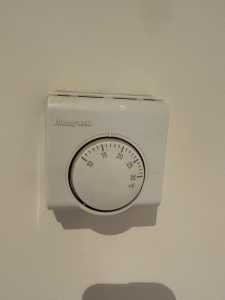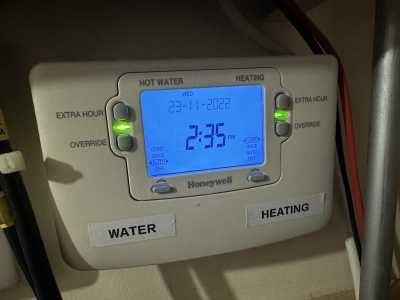Need help explaining how my ASHP heats home vs. water
Hi all, I am really hoping for some advice on here explaining how to use my ASHP. We moved into our new home back in July, but I have really been struggling to figure out how to run the thing.
My first question would be does the ASHP use the water from the hot water tank to circulate around rads and heat the home? Or is that water just for water for showers etc?
We have had the water on heating the tank 24 hours a day at 40 degrees since we have moved in, which has cost about £3 per day according to the electric meter outside (I am not sure this is 100% accurate and we don't have a smart meter so this is just approx for total electricity and includes perhaps one clothes wash per day and one dish washe cycle too). I did change it to just coming on two hours twice per day and it was cheaper this way, but not enough to warrant not having hot water available at all times.
As autumn approached I had a play around with introducing heating into the mix, and against advice it seemed that it was much cheaper to just have this timed to a couple of hours a day whilst we are in, rather than heating on all day. Now the temperature has dropped my husband was at home with the heating on most of the day on Monday, and it cost a whopping £9 in electric for that day (hot water on constant as normal too, as well as one load of washing done, which is not out of the ordinary). I should say in our trials before we did previous have both water and heating on 24/7 at 16 degree home thermostat temp for a week and again was not cheaper than it coming on and off.
We have a 4 bedroom town house which is 12 years old and well insulated. The heating is controlled by a single thermostat which is currently set to 16/17 degrees. Any advice on some changes to optimise things would be really appreciated. Or even just an explanation of how it is heating the water and home so I can understand the interplay of having hot water on constant and heating too.
Thanks in advance 🙂
The hot water in the cylinder is not used in your central heating system.
Is your hot water being heated by your heat pump or by an immersion heater?
Does your townhouse have 2 or 3 outside walls?
What is your electricity tariff? It would be better discussing kWh as measured by your electricity meter.
Assuming that you are on the standard electricity tariff of 34p per kWh, then £3 would equate to approximately 8.8kWh of energy use, which is probably about average. To reduce electricity usage and cost you should try to ensure that the washing machine and dishwasher are fully loaded.
If you are now using £9 of electricity for normal use and central heating, then the central heating is costing approximately £6, which would equate to about 17.5kWh of energy. Without knowing the exact heat loss of your home, and the make and model of your heat pump, it is difficult to say if this is an acceptable amount of heat energy to produce an indoor air temperature of 16/17C.
How warm are the radiators getting to the touch? Are they quite hot?
To answer, as above, no hot water goes to a cylinder. Somewhere in your house there is a tank, maybe in the loft? That water is just for domestic use (you might see people use the acronym DHW - domestic hot water). Generally the ASHP will do the hot water tank as a priority and then the heating system. There is usually some kind of delay on this also e.g. you cant reheat the hot water twice within 90mins. Generally I would say that on demand hot water is fine, but 40 degrees seems quite low, I imagine it loses temp quite quickly when you are showering etc.
Yeah this post doesn't tell me anything really. £9 per day in electricity is probably well within the normal range at current prices - that's 26kw. Given most homes will use 9-15kw on normal day to day things e.g washing, cooking, lights etc I don't see this amount as being excessive as you are also providing your heating/hot water as well.
I used 37kw yesterday on heating and hot water - my house might be bigger and its certainly warmer (21 degrees all day) - so I don't see these figures as crazy.
@enc - Questions
- How large is your house (approx m2 would be fine)
- Do you know its EPC
- Do you know your insulation levels?
- What make/model is your ASHP
- Where is your ASHP controller? NOT the thermostat, but a controller box for the ASHP. Usually they get shoved away in a cupboard.
- Do you know the settings on your ASHP? e.g. weather compensation
- Is your water also heated by an immersion booster?
- How hot do your radiators get?
- Are those rads on all the time? or just a few times a day?
- How big is your hot water tank?
@derek-m thanks so much for your response :)!
Interesting that the hot water cylinder is not used in the central heating system, I didn't realise this! The hot water cylinder is heated via the heat pump, except for once a week the immersion is on for 2 hours to 60 degrees. Townhouse has two outside walls.
We are on standard variable tariff at the moment. Looking at yesterdays usage this was 12.1kwh and £4.60 when we were both in the office all day. So no washing machine or dishwasher usage, one shower and heating on for 8 hours of the day at 16 degrees.
Today we are already at 12kwh at 11.51am and that is heating at 17 degrees for 6 hours, one washing machine cycle, no showers yet.
We have a mitsubushi ecodan pump and the radiators I would say are hot to touch but not so hot you cant hold your hand on them.
Thanks so much again.
Emma
@batalto Thank you for your reply 🙂
Eak so sounds like things have just got v. expensive. It is probably worth noting we came from a 1 bedroom flat where we didn't use the heating at all as it was so warm, so it could well be my perception of the cost. Still it would be great to learn and understand how best to control the system so we are running it efficiently.
In response to your questions
- How large is your house (approx m2 would be fine)
- 140m2
- Do you know its EPC
- B
- Do you know your insulation levels?
- All I know with respect to this is we have 30 cm loft insulation which is boarding using a raised platform system.
- What make/model is your ASHP
- Mitsubushi ecodan
- Where is your ASHP controller? NOT the thermostat, but a controller box for the ASHP. Usually they get shoved away in a cupboard.
- This is in a cupboard with our water tank. I just noticed that this is running the heating in 'Eco heating' which looks like it is set to 46 degrees but I cant change the temp, and I don't know how to select which mode to run it in either. Checked and hot water on that controller is on 42 degrees and the normal heating mode was at 58 degrees.
- Do you know the settings on your ASHP? e.g. weather compensation
- Absolutely no idea 🙁
- Is your water also heated by an immersion booster?
- Yes once per week
- How hot do your radiators get?
- Quite hot to touch, but you can hold your hands on them
- Are those rads on all the time? or just a few times a day?
- Rads are on and dont have their own thermostat controllers
- How big is your hot water tank?
- Literally no idea and couldnt see it written on it.
Hi Emma,
The hot water cylinder is filled with the water used for showering and at the hot taps, but also inside the hot water cylinder is a coil of copper tubing through which passes the warm water from your heat pump. The coil acts as a heat exchanger, so that the warm water from your heat pump transfers heat energy into the DHW within the cylinder. In this way the water used within your heat pump and radiators is kept separate from the DHW in the cylinder.
Do you know the model or size of your heat pump?
I'm afraid that the way that you are operating your heat pump is far from ideal, but then may be the more cost effective way for you. Let me explain a little of how an ASHP works and how to obtain highest efficiency. How technical are you or your husband?
A heat pump is designed to get most of its heat energy (think fuel supply) by absorbing energy from the outside air, the remaining energy is obtained from the electricity supply. So on warmer days it may get 1kW of energy from the electricity supply and 3kW from the outside air, and in doing so give out 4kW of heat energy. On cold days it will draw 1kW from the electricity supply, but may only get 2kW from the outside air. So as you can see, one of the major weaknesses of ASHP's is that they get less 'free' energy from the outside air, at the very time that they need to produce more heat energy because the heating demand is greater. The efficiency of a heat pump is therefore reduced by the mere fact that the outside air temperature is lower.
A further factor which impacts the efficiency of an ASHP is how hard it is working. As the outside air temperature falls, the heat loss and hence heat demand of your home increases, which means that the heat pump must work harder to meet the heat demand. It does this by increasing the Leaving Water Temperature (LWT), which is required to make the radiators warmer and hence keep the rooms at the desired temperature.
You are probably thinking that all this is very interesting, but it does not answer my question.
For best efficiency a heat pump should be run in a continuous mode utilising Weather Compensation (WC). This is like driving your car at a continuous reasonable speed and avoiding fast acceleration and hard braking. The radiators should get barely warm and in warmer weather may be cool to the touch. I suppose this is fine if you are at home all through the day. Do you find that 16/17C is warm enough?
In your situation, where there is no one at home during the day, it may be preferable to turn down the heating by 1C or 2C during the day, and then increase the temperature just before, or when, you arrive home. A further possible efficiency improvement may be to heat your hot water cylinder during the warmer part of the day when the heat pump is operating more efficiently.
The first thing that you need to do is check if your heat pump is operating in WC mode. If you look under KevM's posts on the forum, there is detailed information of how to check and set WC mode.
Hi Emma,
can you post a picture of the Mitsubishi controller? That will give an idea of how things are set up now. Can you describe how you adjust the room temperature? Is it with a Mitsubishi controller or something else?
@enc the others will help you here. I've not got an Ecodan. However I can guarantee you that you can save money. Your rads are way too warm for your thermostat temps. Your heating is very close to mine and my house is 21° all day and night. You should easily be able to turn down the temps and get a far lower cost for your bills. What you'll have at the moment is a lot of cycling on and off. What you're aiming for is a constant, very low temperature which runs all the time you want it to.
Just follow the steps to turn down your weather compensation on the controller
@kev-m please see attached controllers I have. It is currently in eco mode which is the weather compensation mode. However this is at 47 with no clear way of being able to adjust this temperature manually. It just flashes when I touch the controllers. I am able to adjust the normal mode, hot water and antifreeze though.
for adjusting the room temperature I just spin the dial on the Honeywell room thermostat which is in my hallway 1 degree. The rads I don’t really touch although they have the standard 1 through 5 dials.
thanks,
Emma
Hi Emma, check what your house thermostat is doing set at 16/17degC. Is it switching the ASHP on and off continuously? If it is that's a very inefficient way to control the ASHP. Most room thermostats are fancy switches. An ASHP works most efficiently when it runs for long periods. It then modulates down to supply lower heat output based on weather compensation control and return water temperature. It will do it's thing if it is allowed to. If the room thermostat keeps switching it on and off every 15-30 minutes it never gets a chance. Control your house room temperature by thermostat radiator valves and ensure the room thermostat is calling for heating. That means simply setting it higher than the temperature you want in the rooms.
@derek-m Just had a look at the heat pump. It is Ecodan PUHZ-W85VHA2-BS 8.5kw.
In terms of technical abilities ... we both have degrees in chemistry but 0 heating engineering knowledge so it is all learning from here. So it seems like there are quite a few factors at play decreasing the efficiency in the colder months. Are the radiators themselves impacting how its running then? Though we don't have smart thermostats on them, I am assuming that the higher the 1-5 dials are, the more water they are cycling through and the most heat is used?
Our thermostat is at the bottom of the house in the cold hallway with one radiator we are not able to turn up or down, so when the heating is on the downstairs is not really warm enough at 16/17 degrees, but upstairs is almost too hot! I believe it it set to water compensation mode. Is this an auto mode or is there a way to config this too to turn the water flow temp down a bit?
I have just read somewhere with the ecodan that it is more efficient to have the heating on all the time and just the hot water twice a day as running them concurrently leads to excessively high usage, although that seems to be an unsupported statement.
Thanks,
Emma
- 26 Forums
- 2,356 Topics
- 53.4 K Posts
- 244 Online
- 6,017 Members
Join Us!
Worth Watching
Latest Posts
-
RE: Electricity price predictions
Ben Watts posted on LinkedIn that he had updated this w...
By Judith , 3 hours ago
-

RE: The good, the bad and the not that great – my heat pump installation
Small update, Emailed and Spoke to Midea UK and they ...
By Burtis , 3 hours ago
-
RE: Solis S6-EH1P8K-L-PLUS – Why I Chose It and What I’ve Learned So Far
@bash Octopus does charge for the admin. The process al...
By Batpred , 3 hours ago
-
RE: External pipework insulation
@transparent HI all The products you mention are ver...
By David Smith , 3 hours ago
-
RE: New Fogstar 15.5kWh upright solution
Issues still under investigation by Solis... Fogstar ...
By Batpred , 4 hours ago
-
RE: Who's your electricity provider and what's your tariff?
I agree, the consumer is not being properly represented...
By Batpred , 4 hours ago
-

RE: Controlling Daikin Altherma via P1P2 and Home Assistant
@weoleyric, apologies for the delay in response. Give...
By Majordennisbloodnok , 5 hours ago
-
RE: Octopus Cosy Heat Pump Owners & Discussion Thread
@harrisonc wow. That’s going to get the rumour mill gr...
By AndrewJ , 7 hours ago
-
RE: Advice on internal circulation pump noise
Thanks @mikefl - I'll maybe have a look at the lock-shi...
By jtg , 21 hours ago
-

RE: Heat Pump Heats the House… But It’s Not Cosy. Emitter Changes or System Tweak?
@toodles interesting suggestion, thanks. I will try to...
By GrahamF , 21 hours ago
-
RE: Mitsubishi Ecodan Auto Adaption trial to stop cycling.
The interval you talk of, i think, will be 60min for an...
By F1p , 1 day ago
-
Agree with @majordennisbloodnok on the setbacks. We hav...
By ChandyKris , 2 days ago
-

RE: Speedcomfort radiator fans
@deltona the way the links were added broke the page. A...
By Mars , 2 days ago
-

RE: Setback savings - fact or fiction?
I agree! Even more so if we get an answer! But the chal...
By cathodeRay , 2 days ago
-

RE: Refrigerant R32, is it now banned in the EU from 1st Jan 2027 for monobloc ASHPs?
This has been delayed from what I believe to be this ye...
By dgclimatecontrol , 2 days ago
-
RE: Are We Sleepwalking Into Another Race to the Bottom?
this is why I provided current flow temperatures in the...
By ksim , 2 days ago
-

RE: Why Millions of UK Homes Struggle With Heat Pumps
There's many homes that would be quite a disruption for...
By dgclimatecontrol , 2 days ago
-
RE: Ecodan unable to hit legionella target temp - what's the consensus?
@rhh2348 ...maybe this option is what you want? Alter...
By benson , 2 days ago
-

RE: Free Ecoheat Heat Pump Install
@old_scientist This does make the unit smaller as the b...
By dgclimatecontrol , 2 days ago







